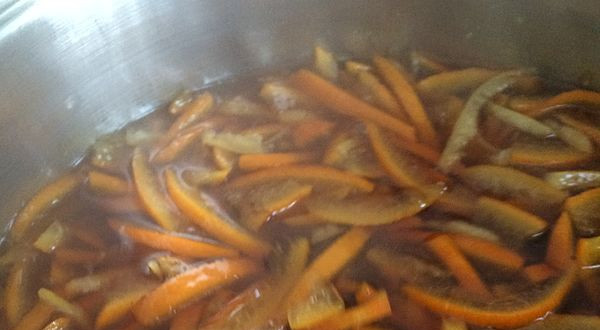Seville Orange Marmalade
Olive Flynn

Like the chutney, this is my mother’s recipe. Seville oranges only come round once a year, at the end of January and start of February, so you have to watch for them, and buy them the moment you see them. 4 Kg makes enough marmalade for the year, including jars to give to friends.
My local grocery knows the oranges just as “marmalade oranges” but they are easily distinguished by having a rough skin, and by being much smaller and more varied in colour than the boringly perfect bright, smooth colour of the cultivated dessert orange. Inside they have a looser texture, lots more pips, and a thick pith that detaches from the skin more readily than with Valencian or Andalucian dessert oranges. You need all of this, because prep is a pain in the butt, but well worth it.
Quantities. My oranges came in 2Kg boxes, with 15 oranges to the box, so this recipe used 30 oranges, and this year (2025) they were very juicy and (with the lemon) produced 1.2ℓ of juice. That meant 3 × 1.2ℓ = 3.6ℓ of water and 3.6Kg of sugar, but in lean years it would be less.
Your support for our advertisers helps cover the cost of hosting, research, and maintenance of this site
Ingredients
- 4 Kg Seville oranges
- 1 lemon
- 3 ℓ water [approx, see above]
- 3 Kg jam sugar | this is normal caster sugar with some pectin added [approx, see above]
- 1 oz unsalted butter [optional]
- 20 × 250 ml jars [glass jam-jars, with lids if possible]
- 1 packet [optional] [jam-jar covers]
Method
Halve the oranges and the lemon and squeeze out the juice, straining it into a large measuring jug. From 4 Kg oranges you should get a little over a liter of juice. Pour the juice into a large preserving-pan.
With a sharp-edged metal spoon (I use an old-fashioned EPNS dessert spoon) carefully scrape away all the white pith from the inside of each orange half, separating it so you you can see the inside of the peel without cutting or tearing it. This is infinitely tedious but the only way to get the fine thin strips of peel necessary for high-quality marmalade.
If you really can't face it, roughly scrape the pith from the halves and then push all the remaining peel through a mincer using the medium mesh. It won't be as pretty but it's a lot faster.
Wrap the pith loosely in a large muslin square and tie tightly with twine to make a bag from which no pith can escape. Add the bag to the juice in the pan.
Shred about ⅓–½ of the peel into fine slivers with a very sharp large knife, unless you went for the mincing option above. Add the minced or shredded peel to the pan.
Add three times the volume of juice in water, so for 1 liter of juice, add 3 liters of water.
Bring to the boil, stirring occasionally, and boil gently for about 2 hours until the shreds of peel are perfectly soft and can be crushed easily under a fingernail.
Remove the bag of pith and squeeze out hard between two large plates so that all the pectin (a clear jelly that makes jam set) is recovered. Add the pectin to the pan. Seville oranges do not normally need additional pectin.
Add the sugar and bring back to the boil, stirring constantly until the sugar is dissolved, when the cloudy mixture will miraculously go clear golden orange. Adjust the heat to boil it hard without foaming up and boiling over, until it reaches setting point (about 105°C or 220°F), probably about 1 hour.
While it's boiling, put the s with their lids separated on a baking tray and put them in the oven at 120°C (250°F) to sterilise. If any of the lids are plastic, don't put them in the oven! Put a few small saucers into the fridge to chill down for the wrinkle test.
Test for the temperature with a candy thermometer if you have one, or use the wrinkle test: take 1 tsp of the mix from the pan and dribble onto a cold plate. Put the plate back in the fridge for 2–3 minutes. Take it out and push the mixture gently with your fingernail. If it wrinkles or has already started to set, you're done. If not, keep boiling for 10 minutes and try again.
When it's done, stir in the knob of butter and mix well. If you want vegan marmalade, omit the butter.
Take the sterilised jars from the oven and ladle the marmalade carefully into each. Use a funnel to avoid spilling too much (I use the funnel that came with my dishwasher for adding salt, as it's exactly the right diameter for a jam jar).
Hold the jars with an oven glove and twist on the lids. As the mix cools, it will suck down the lid like the vacuum-packed ones you buy.
If you have no lids, use a packet of jam-pot . These are cellophane discs, with wax tissue discs and rubber bands. The wax tissue discs go on the surface of the marmalade in the jar, and the cellophane covers the mouth of the jar, held in place with the rubber band. More fancy packages come with cotton gingham covers to make it look like your grandma's work.
Serving
Leave to cool, then label and store. Or distribute to friends and relations. Either way, make lots of toast and butter to try it out.
Your support for our advertisers helps cover the cost of hosting, research, and maintenance of this site